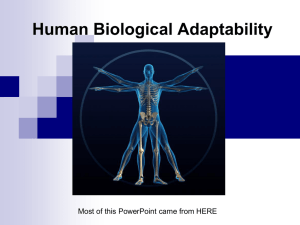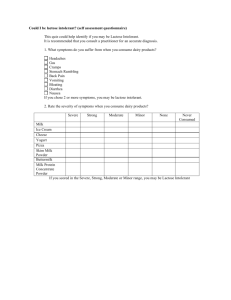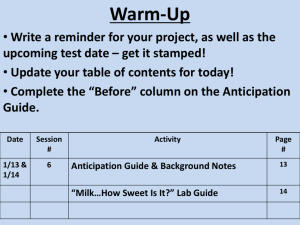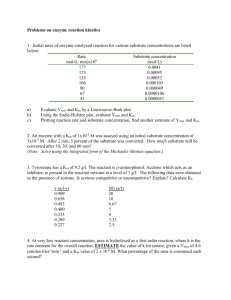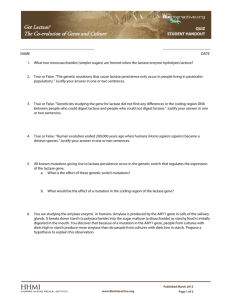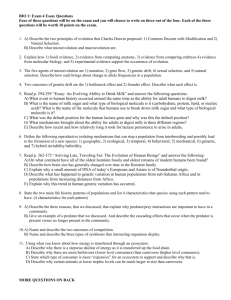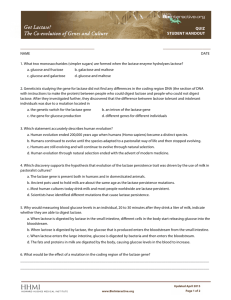File
advertisement
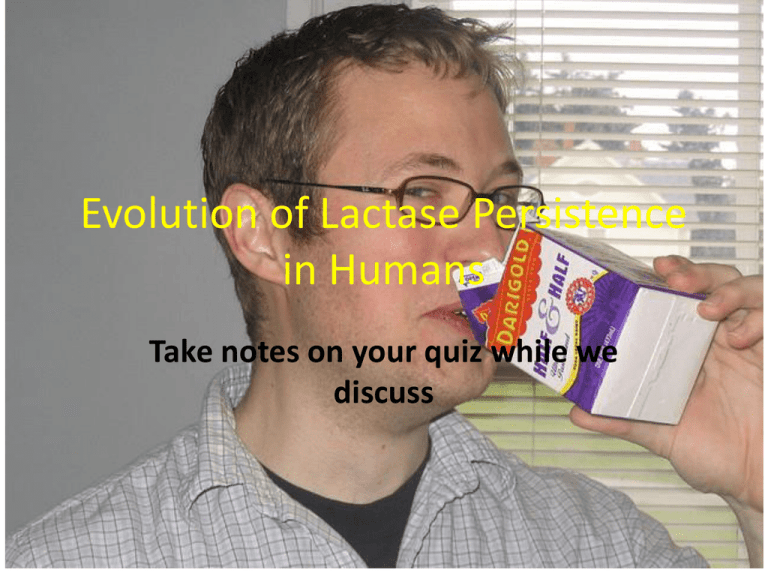
Evolution of Lactase Persistence in Humans Take notes on your quiz while we discuss Humans Become Pastoralists • Humans Become Pastoralists: Humans (Homo sapiens sapiens) evolved into a distinct species around 200,000 years ago in what is now Africa. Whereas some human populations remained in Africa, others followed the path of previous populations of the Homo genus (e.g., H. erectus and H. sapiens neanderthalensis) by moving north out of Africa. Homo sapiens sapiens eventually populated almost the entire globe as the other species of the Homo genus went extinct. Humans Become Pastoralists • For 190,000 years, these radiating populations of humans survived primarily by hunting animals and gathering plant-based foods. But between 10,000 and 7,500 years ago, during the Neolithic Period, small groups of humans in both Africa and Europe began domesticating animals, including other mammals like goats, sheep, and cows. This practice of tending herbivores, called pastoralism, gave these cultures a reliable and predictable source of meat, milk, and milk products, such as butter, cheese, and yogurt. Infant Mammals Depend on Mother’s Milk • Infant Mammals Depend on Mother’s Milk: A characteristic that unites all mammal species is lactation; mammal mothers produce milk specifically to be consumed by their infant offspring. Infant mammals consume their mother’s milk from birth to weaning, when they become able to eat solid foods. Milk has a remarkable nutritional content in that it is loaded with diverse calories—half the calories in milk come from fat, 30% from carbohydrates (sugars), and 20% from protein. These complex calories require a multistep digestion process in order to yield useful energy to the body’s cells. Upon consumption, milk proteins are digested in the stomach, whereas fat and sugar metabolism occurs primarily in the small intestine. The main sugar in milk is the disaccharide lactose. Infant mammals use the enzyme lactase to cleave the lactose into the monosaccharides glucose and galactose in the small intestine. Lactose Digestion • Lactose Digestion: Cells called enterocytes that line the small intestine produce the lactase enzyme in mammals. These cells have tiny fingerlike projections of their cell membranes called microvilli. The microvilli increase the surface area of the enterocytes and make the digestive process more efficient. Lactase enzyme is produced on the surface of the microvilli, where it digests lactose. Lactase enzyme Lactase enzyme Lactose hydrolysis Lactose hydrolysis Glucose and Galactose from Lactose • Both glucose and galactose diffuse through the intestinal wall, enter the bloodstream, and are delivered to the body’s cells, where they are converted to cellular energy. (Galactose is eventually converted to glucose in cells of the intestine.) Glucose is the main energy source on which nearly all cells of all organisms depend, and most of the foods we consume are eventually converted to glucose. Lactase production • After mammalian infants are weaned from their mother’s milk, the gene that produces lactase is turned off and the lactase protein is no longer present on the surface of the microvilli. Shutting down lactase production when it’s no longer needed makes evolutionary sense. Once mammals are no longer nursing and their mothers are no longer producing milk, continuing to synthesize lactase would be a waste of energy. Lactose intolerance • If people without sufficient lactase production drink milk, they may experience abdominal pain and diarrhea and are called lactose intolerant. Undigested lactose flows from the small intestine into the large intestine, where it can make it difficult for the intestines to reabsorb water, causing diarrhea. The lactose is partially digested by the gut’s microbial community, through a process known as fermentation that produces the gases carbon dioxide, hydrogen, and methane, all of which can cause abdominal pain, bloating, and flatulence. Mutations for lactase persistence • Independent Mutations: Five different mutations are known to be associated with keeping lactase production turned on into adulthood—a trait called lactase persistence. All five mutations (shown in the figure below) occur in a regulatory element, known as a genetic “switch,” for the lactase gene on chromosome 2. The lactase switch is in a segment of DNA in a neighboring gene called MCM6, and all the mutations are within two of the introns of that gene. Gene-Culture Co-evolution • Gene-Culture Co-evolution: Genetic analysis suggests that the mutations associated with lactase persistence arose less than 10,000 years ago. They increased in frequency in populations that were pastoralist—which means they kept and used domesticated animals. A practice like pastoralism is called cultural because it is taught and learned and it is not an instinct dependent on the transmission of genetic variations (see last discussion point). Gene-Culture Co-evolution • In pastoralist populations, individuals with the lactase persistence mutations were more likely to survive, reproduce, and pass on their alleles than people without the mutations, especially in times of famine. What’s more, individuals only need one copy of the mutated switch to be lactase persistent; thus, the trait is inherited in a dominant pattern. Over just a few dozen generations, the frequency of the lactasepersistence allele could have increased rapidly under intense positive selection. The increase in the number of individuals in these populations that were lactase persistent meant that more and more people would depend on milk from their livestock herds, especially cows, further promoting the culture of pastoralism. Milk in the diet Today, milk and milk products are a significant part of the human diet all over the world, not just in regions where people are predominantly lactose tolerant. In China, where most people are thought to be lactose intolerant, the average perperson consumption of milk was 30 kg in 2009, while in Finland, it was 375 kg, according to the Food and Agriculture Organization of the United Nations. These are huge numbers considering that 375 kg a year is equivalent to each person drinking about one liter of milk a day. However, these numbers include total milk consumption in a country (in other words, all the milk that is used by the population—both as a beverage and in other foods, such as cheese, ice cream, sauces, and baked goods—divided by the number of people in that population). Milk allergy Students may confuse lactose intolerance with milk allergy. Globally, 2% to 6% of infants and 0.1% to 0.5% of adults suffer from cow’s milk allergy. Milk allergy is a potentially much more serious condition involving an inflammatory immune response to some of the proteins in cow’s milk that are not found in human milk. Lactose intolerance does not involve the immune system but rather a low amount of the enzyme needed to digest lactose. Most people are lactose intolerant Students may be surprised to learn that most people in the world are lactose intolerant. They may not know anyone who cannot digest milk. That is likely due to several factors: 1) they might live in a population that is predominantly lactose tolerant; 2) individuals who are intolerant can have very mild symptoms and still be able to consume milk in small quantities; 3) products like Lactaid can be taken to facilitate milk digestion; and 4) many people may not want to discuss having mild but embarrassing symptoms. In addition, many lactose-intolerant individuals have little problem handling milk products, like cheese and yogurt, because these foods tend to have much lower concentrations of lactose than milk has. A. B. C. D. E. F. G. Got Lactase? - Key Concepts Humans, like all species, evolve and adapt to the environment through natural selection. Lactase persistence is an example of a human adaptation that arose within the last 10,000 years in response to a cultural change. Mutations occur at random; for evolution to occur there must be selection for or against the traits affected by those mutations. Both the physical and cultural environment can affect selective pressures. The practice of dairying provided an environment in which lactase persistence was advantageous. Different mutations can produce the same phenotype. Scientists have identified distinct mutations among northern Europeans and the Maasai people of eastern Africa that resulted in lactase persistence. Similar phenotypes can evolve independently under similar selective pressures. The lactase persistence trait arose independently among African and European pastoralist populations. Mutations occur not only in coding regions of genes but also in the regulatory regions that determine when and where a gene is turned on. All known mutations giving rise to lactase persistence are in a genetic “switch” that regulates expression of the lactase gene. Food has to be converted into simpler molecules that can be absorbed and used by cells in the body. The lactase enzyme breaks down the disaccharide lactose into glucose and galactose. Class set- DO NOT WRITE ON THIS SHEET
